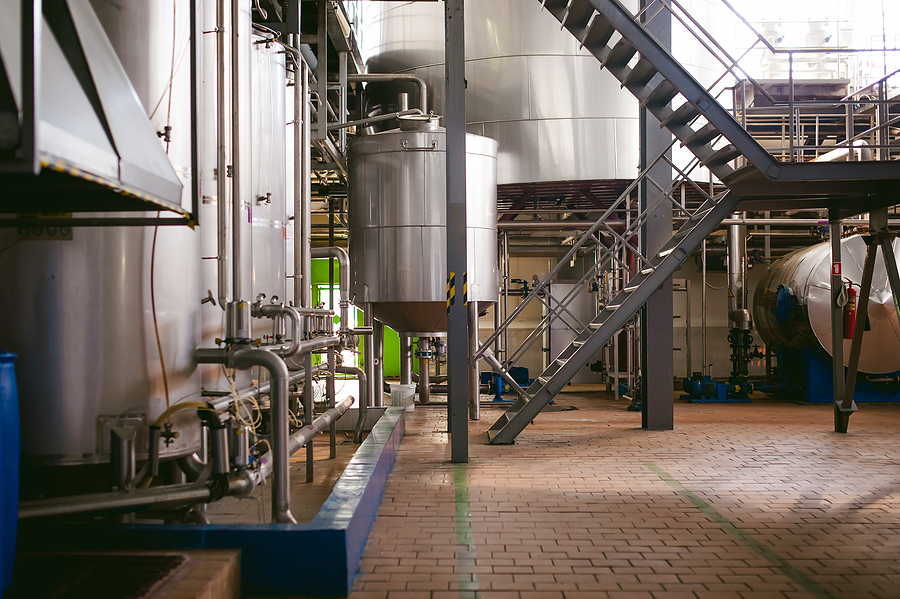6 Common Hazards in the Food Production Industry

In food production, a lot of focus is on food safety. After all, the product is designed to be consumed by people so it needs to be safe. This makes complete sense, but it’s important that those operating these facilities don’t lose focus on worker safety as well. Food production is no different than a manufacturing floor. Many similar hazards exist, some even compounded by the addition of food products and/or the precautions being taken to keep those products safe for consumption. The following are some prime examples of hazards endangering your employees as opposed to the ones that are endangering your food.
Slips, Trips, and Falls
Slip, trip, and fall hazards exist in just about every workplace. The difference becomes the number of hazards, the severity of those hazards, and the conditions of the surrounding workplace that contribute to the severity of the hazard. Tripping over an upturned corner of a mat, for instance, is bad and can result in any number of injuries. Tripping over an upturned corner of a mat and crashing into a hazardous substance or an unguarded machine is significantly worse. A thorough hazard analysis of your facility should focus a great deal of attention on where these slip, trip, and fall hazards are hiding.
In addition, dealing with food often leaves to sticky or slippery substances puddling up or coating the floor. Ensuring scheduled cleaning takes place is important, but not enough. Workers should be wearing the proper footwear for your facility and should be provided with anti-slip mats on walking/working surfaces.
Machine Guarding
Just as in any manufacturing facility, food production could have machinery that includes rolling parts, blades, and presses among other things. This machinery presents pinch-points that could result in injury, amputations, or death if not properly protected. A full review of your equipment and its guarding needs to be done to ensure workers aren’t placing themselves or parts of their bodies in harm’s way. These guards can be made in a variety of ways, but if your guard is removable, it should be interlocked to prevent a worker from removing it while the machine is operational.
Most importantly, your workers need to be trained. Workers manage to come up with ingenious ways to bypass guards if they feel it is hindering their performance. They need to be taught the inherent danger in removing a guard, that operating equipment without a guard is unacceptable, and what to do if a guard is broken or missing. From that point, plant management needs to support these rules with their actions. If supervisors are turning a blind eye to missing guards, taking long amounts of time to fix guards while insisting production not be stopped, or, worse, actively encouraging workers to remove guards to speed up production, then you have a serious safety issue on your hands – not to mention a liability issue.
Harmful Substances
Many harmful substances can be used in food production (not necessarily on or in the food). Ammonia, for example, is a common refrigerant due to its thermodynamic properties and its low cost. It is a very hazardous substance, albeit one that in smaller amounts will drive people away from it because of its irritating characteristics. However, that doesn’t mean that you don’t need to protect your workforce. Releases in confined spaces or quick, large releases could lead to severe illness and death.
Protection from hazardous chemicals begins with education. Ensure that not only are SDSs available to your workforce, but that they’ve been trained on the chemicals used in the workspace, including relevant first aid, what to do in the event of a release, and identifying characteristics. Once they understand the hazard, they can be taught the proper procedures for working around or working with the chemical and what PPE is required. Ensure that your facility has looked at any substitution options as well. In other words, is there a less hazardous or non-hazardous substance that could be used in place of the hazardous one? Substitution (elimination) should always be the first choice in protecting your workers, though it’s not always possible.
Noise
Machinery has the tendency to be loud. It’s important that you evaluate your facility for noise hazards. As with the hazardous substances, if a noise hazard exists, but can be eliminated, then that’s the route you should take. If that’s not possible, engineering out the hazard is your next step per the hierarchy of controls. Can the equipment be made differently or can it be guarded in a way to reduce the noise to acceptable levels? Again, this won’t always be possible. In that situation, you proceed to administrative controls – things like limiting a worker’s time in the noisy area (most likely coupled with the final step in the hierarchy: PPE). Be aware of your requirement to have a Hearing Conservation Program, as well, and make sure you are compliant should the program be warranted.
Electrical
Machinery needs power. With great power comes great responsibility…to protect your workers from it. Inspections of wiring, protections of energized parts, grounding of equipment, GFCI protection, and lockout/tagout programs are all considerations in a food production facility. Keep in mind that lockout/tagout is not limited to electrical hazards. Any potential unexpected startup or release of energy needs to be protected against. Make sure your LO/TO procedures are clear and any diagrams are readily available. Ensure that your staff is trained on the procedures and that your workforce knows that only qualified and authorized people are allowed to perform the maintenance tasks that require LO/TO. And remember, these procedures are not static. They need to be periodically inspected and updated as necessary.
Electrical cords and equipment need to be inspected regularly. Missing guards or damaged wiring needs immediate attention. Never use extension cords or other temporary wiring where permanent wiring is necessary. Make sure your GFCIs and equipment grounds are intact and being tested.
Cut Hazards
Blades are a pretty common sight in a food processing plant, indicating that protection against lacerations should also be common. Review procedures to determine what could be done mechanically, thereby eliminating the possibility of injury, what needs guarding, and where you’ll need PPE, such as cut resistant gloves. And always make sure your blades are sharp. According to the National Food Service Management Institute, dull blades cause more accidents because they are harder to work with, require more pressure and slip more easily.
Conclusion
While this is by no means a comprehensive list of the hazards you could encounter in your food processing facility, it certainly gives you a strong starting point for your hazard analysis. A thorough analysis could raise fall hazards - specifically ones where employees are working over dangerous equipment, heat or cold stress issues, forklift hazards, and more. Ensure that the proper amount of attention is being paid to the safety of your workers, not just the safety of the people that will eat your food.


